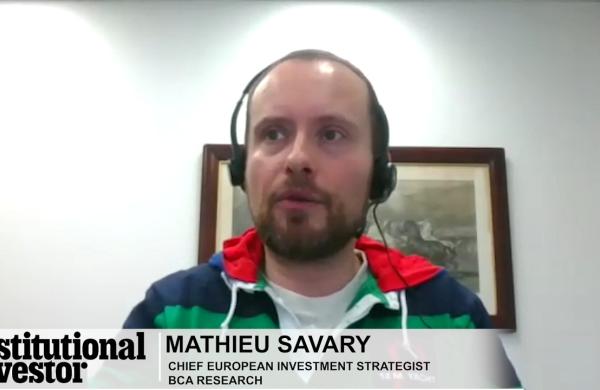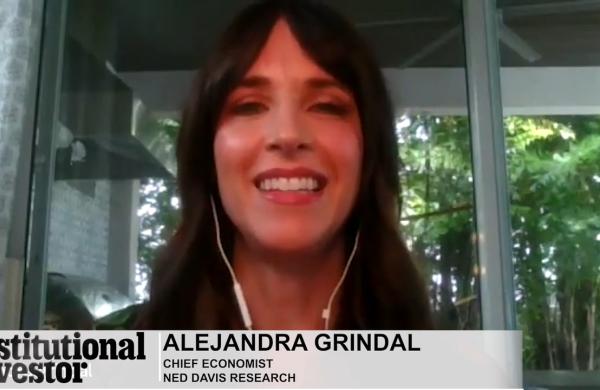Rejected by the London Stock Exchange and reeling from Jiway's poor start, OM's Per Larsson still believes that the world's markets are ripe for his brand of trading technology.
By Sharon Reier
May 2001
Institutional Investor Magazine
Rejected by the London Stock Exchange and reeling from Jiway's poor start, OM's Per Larsson still believes that the world's markets are ripe for his brand of trading technology.
As a business student in the early 1980s, Per Larsson founded a company that produced some of Sweden's first music videos. Now, as president and CEO of Sweden's OM, he produces something else that revolves around performance: securities markets - everything you'd need to start your own exchange (except the securities themselves). In addition, OM operates a number of exchanges of its own, most notably the Stockholm Stock Exchange.
But after what Larsson has gone through this past year, maybe he would be better off if he went back to making music videos. At least he could control the script.
OM's audacious - some said outrageous - bid to buy the London Stock Exchange last summer turned out to be a spectacular bust. Its ambitious Jiway pan-European exchange is shaping up as an embarrassing flop. And the much-diminished trading volume on stock exchanges in these lousy markets has taken a mighty whack out of its profits. OM's stock is down 66 percent from its peak in early 2000. Imagine the painful irony of supplying the sophisticated software to allow disgruntled investors to dump your stock faster!
OM has stumbled badly. Can this maker of markets recover its momentum? Torvald Bohlin, CEO of Stockholm Stock Exchange member NeoNet, says: "The real question for OM now is, What's next? What can they do to be successful as a global player?" Perhaps more to the point for users of trading technology, what do OM's current travails signify for the ongoing wiring of the world's exchanges? Will every last exchange be electronic within five years? And will it be with OM software or that of its multiplying competitors?
It was only last August that Larsson grasped for glory on a global scale by mounting OM's hostile, $1 billion-plus takeover bid for the London exchange. This followed 15 years of solid but modest successes for OM in establishing regional electronic exchanges, beginning with the pioneering formation of a wired options market in Stockholm. The London exchange's leadership, reacting as if the tall, blond Swede were leading a Viking raiding party, bolted the door against Larsson. LSE chairman Don Cruickshank dismissed the bid as "derisory." In the end a mere 6.7 percent of LSE shares wound up being voted for the OM offer.
Now Larsson puts a positive spin on his London misadventure, calling it the "most successful unsuccessful bid ever." How so? "It will be useful going forward," he contends. "We made a lot of new friends. We created a brand. We are perceived as a much stronger partner. The most exciting deals are still out there to be done."
But with the chill in the markets and OM's depressed stock no longer such a gilt-edged currency (though the company's market capitalization still exceeds $1 billion), there haven't been too many big deals to get excited about. One exception: Earlier this year OM picked up the 49 percent of Canada's Natural Gas Exchange that it didn't already own, an indication of Larsson's growing interest in energy marketplaces.
The decline in trading volumes has hurt OM's core exchange business. In addition to the original options market, Options Mäklarna, and the Stockholm Stock Exchange - now officially Stockholmbourse - this consists of niche exchanges in Sweden, the U.K. and Canada. OM's operating profits plummeted 95 percent in the first quarter, to a very modest 15 million kronor ($1.5 million). OM's price-cutting in response to competition back in Sweden and continued big outlays for getting Jiway off the ground also dragged down results.
But the other side of OM's business - selling back-office technology to other exchanges - held up well. Technology sales in the first quarter were actually running ahead of last year's, after having contributed half of the company's Skr3.2 billion in revenues last year. Even as it was storming the LSE last year, OM managed to close a major systems and operations contract with the London Metal Exchange. Then, early this year, it sold new or upgraded systems to the American Stock Exchange and to Hong Kong Exchanges and Clearing. Observes the Amex's chief technology officer, Ravi Apte, "Anyone can try to build an exchange, but there is a time constraint, and we determined it was best to buy."
Indisputably, technology will play a pivotal part in anything that OM undertakes from now on. At the annual meeting in March, Larsson was at pains to point out that fewer than 10 percent of OM's 1,500 employees actually work at the enterprise the firm is so closely identified with: the Stockholmbourse. "It is becoming increasingly important for us to emphasize that OM is not an exchange," he told shareholders. "What is of utmost importance is the further enhancement of our unique core competence that lies within transaction technology."
Technology has in fact always been OM's mantra. Back when a former futures trader, Olof Stenhammar, OM's founder and chairman, opened Sweden's ground-breaking Options Mäklarna in 1985, he hired Larsson as head of fixed-income derivatives. The then-24-year-old, who had written a business school term paper on futures, helped oversee technology development. OM became the first exchange in the world to fully integrate its operations with those of a clearinghouse.
But in a pattern that was to become all too familiar to OM, the member-owners of the Stockholm Stock Exchange pooh-poohed the threat of this upstart, fully electronic exchange that they felt had been so brazen in forsaking the open-outcry custom. Their considered opinion was that there should be only one Swedish futures and options exchange; that they should control it; and that it should have floor traders. "In short," comments Larsson dryly, "it should be conventional."
So the very next year, the exchange members launched their own options market, expecting to drive OM out of business in short order. "They acquired an expensive space on top of a prominent department store," recalls Larsson. "They separated clearing from trading, because that is how it was done [at the Chicago Board Options Exchange]. The traders wore colored jackets. It was not for profit, and we were for profit. We fought it for about a year before they closed down." In 1998 parvenu OM bought the Stockholm Stock Exchange in a stock swap.
On the strength of launching Europe's first privately owned derivatives exchange, OM ventured into technology sales. Starting in 1987 the firm delivered turnkey systems - software plus operational support - to Finland, France and Norway. OM showed its clients how to set up options markets from scratch. "We were selling not only the technology to run the markets, but also product development - the entire system of developing an option," recalls Magnus Karlsson Böcker, who joined OM in 1986 and serves as president of its sales and R&D arm, OM Technology.
In 1991 OM made the first international sale of its Click electronic trading system to OTOB, the Austrian derivatives exchange. OTOB, which later merged with the Vienna Stock Exchange, still uses OM technology. Within three years OM had sold Click to the American Stock Exchange, the Milan Stock Exchange and the Hong Kong Futures Exchange. "That's when we became a real technology player," says Böcker.
But Larsson well appreciates that razzle-dazzle technology alone does not an exchange make. This was a big part of the message in his vainglorious pursuit of the London exchange. When word got out that the LSE was considering a merger with the Deutsche Börse in a putative pairing of equals, Larsson concluded that London was giving itself up for too little. After LSE chairman Cruickshank refused to meet, Larsson sought to appeal directly to exchange members with an £808 million ($1.15 billion) bid (later upped to $1.6 billion). Cruickshank publicly lambasted the offer as contemptuously low and said that OM's proposal "didn't address the issues our customers want."
To Larsson, the real rationale behind merging the London and Frankfurt exchanges came down to sheer bulk - $4 trillion in total market valuation for the combined exchanges. "Most view this business from a wirehouse perspective - 'Who has the biggest market,'" he complains. OM instead offered proprietary trading and clearing platforms that it said would cut costs and make the LSE a cheaper and more inviting venue. "We are not in the game of pan-European consolidation because we have the largest exchange," says Larsson. "We are in the game because we have a strategy and technology that will be the most important thing going forward."
London wasn't about to listen to such arguments, especially from an outsider like OM. "The proposal made sense from a cost and streamlining basis - Sweden is one of the most efficient markets in the world," argues E*Trade Europe head Johan Brenner, who happens to be Swedish himself. "But the situation is very politically driven. It is a big fight between superpowers over where the financial capital of Europe will be." An upstart like OM from a small country like Sweden never stood a chance, Brenner contends.
But Larsson won plaudits as well as brickbats for his efforts. "We were grateful they appeared," says Brian Winterflood, a member of the LSE policy committee and chairman of Winterflood Securities, a market maker in small-cap stocks. "It gave us an excuse to close down the merger with the Germans. We certainly were not in favor of that." What did in that proposal, says the voluble former East Ender, was that the "deal grossly underrated London. It was a 50-50 merger, when we were the much bigger exchange."
Winterflood concedes that "OM has technology and a dynamism in management that we were sadly lacking." But he adds that in terms of trading value, "London is the biggest and most influential market city in Europe. The days of our being the prey are over. We should be the predator going forward."
Larsson takes comfort from such an attitude. "They took our argument and used it against us," he says. Indeed, in January the LSE introduced a new counterparty settlement system with CrestCo and the London Clearing House that is not dissimilar to what OM would likely have introduced. And under new CEO Clara Furse, the LSE has proclaimed a commitment to technology, even to the point of launching a pan-European trading service to compete with Jiway.
This only underscores, however, how much Larsson has riding on that problem-ridden start-up. Jiway was touted as a revolutionary "single entry point" for retail trading in the stocks of 6,000 U.S. and European companies. The day after the Jiway venture was unveiled in February 2000, OM's share price hit its all-time high of about $52. Fourteen months later it was down to about $17.
Jiway's plausible operating concept was that the participation of co-owner Morgan Stanley as a market maker would guarantee liquidity while that of OM as a whiz at trading technology would ensure smooth and efficient transaction-processing. By centralizing clearing and settlement functions, Jiway would drastically cut the steep transaction costs that have stifled cross-border retail stock trading in Europe. Jiway charges just E7 ($6.30) per foreign trade. Participating brokerages are free to pass on as much of the savings as they like to clients, who have been charged anywhere from $20 to $100 per trade. Jiway opened for trading last November 17 to the accompaniment of popping champagne corks.
But the exchange soon ran into what Larsson delicately calls "tough times." Jiway lost $30 million in 2000 and $10 million more in 2001's first quarter. Yet lavish launch expenses and the growing pains of a 250-employee start-up are not in themselves that worrying. Admittedly, too, this has not been an ideal market in which to baptize any sort of equity-trading scheme.
But Jiway appears to be suffering a seriously debilitating lack of momentum. Of nearly 30 brokerages signed up to participate, only ten are on the system. Ostensibly, the installation delays are more the brokerages' fault than OM's. In any case, Jiway handled just 577 trades in March, whereas analysts say that it needs to do thousands each day to turn a profit. Achieving that sort of volume could get even tougher as institutions such as Citibank and Merrill Lynch & Co. develop pan-European platforms of their own.
Still, Larsson resolutely projects profitability for Jiway by the end of next year. He sees an investing landscape that has been permanently altered by online trading as well as by pension reforms that put individuals in charge of their own nest eggs. "You need infrastructure for trading across borders," argues Larsson, "and that is where Jiway is the equalizer."
Jiway represents only a modest proportion of OM's business, but as NeoNet's Bohlin notes, the company "put a lot of its prestige into Jiway." Technology analyst Matthias Gredmark of Scandinavian bank Nordea says, "The key to the stock price is some kind of turnaround in Jiway." If it doesn't show promise within a year, he predicts, OM will close it down, and that "would probably be very positive for the share price."
The growing pains have prompted speculation that Morgan Stanley, which owns 40 percent of Jiway to OM's 60 percent, is either groping for the escape hatch or trying to round up additional investors. So far the Wall Street firm has invested a publicly disclosed $35 million in Jiway, though the real sum is probably higher because of the steep launch costs. (Morgan Stanley declines to comment on its Jiway commitment.)
With its exchange strategies suffering, OM's best hope for promotion to the international first division may be as a technology vendor. "We have operations in 12 countries at 16 sites and customers in 20 exchanges," says OM Technology chief Böcker. "If you look at all our offerings, we are providing technology to the financial markets, exchanges and clearing markets, energy trading and security systems. What's interesting, looking to the future, is that all of those will be spending continuously on information technology. So this is a great business to be in."
For his part, Larsson warns executives of existing exchanges to be prepared for competitive assaults not just from other exchanges, but also from their own members. Something like that happened right under Larsson's nose. Concerned that OM might be displaying the same monopolistic tendencies that it decries in other exchanges, Stockholm brokerages invited Eurex, an alliance of the Deutsche Optibörse and the Swiss Options Market, to propose an alternative platform for trading Scandinavian derivatives. "The brokers called in Eurex because they thought our fees were too high," concedes Simon Nathanson, the Stockholm exchange's chief operating officer and acting president. OM recently responded by slashing commissions 40 percent. Eurex remains at bay.
The need to stay competitive is the message that Larsson keeps harping on to exchange executives. They must break free from a "false sense of security," he says. "When financial markets are deregulated and there are no longer monopolies, then there is a new competitive climate. You no longer have a club." For OM, he adds, "competition is a natural process." It had better be, given the challenges ahead.





